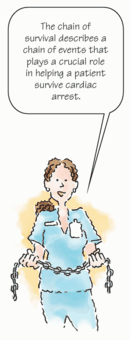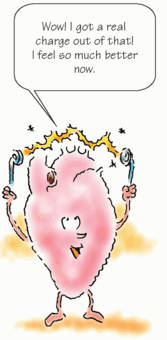ACLS in Practice
 Just the facts
Just the factsIn this chapter, you’ll learn:
American Heart Association’s “chain of survival”
CABD surveys that form the basis of advanced cardiac life support
phased-response approach to emergency response team management
purpose of treatment algorithms.
The chain of survival
The chain of survival describes a chain of events—each interdependent—that plays a crucial role in helping a patient survive cardiac arrest. This series of events is called a “chain” because each link must be strong for the process to work. If one link is weak or missing, poor survival rates will result even if the rest of the emergency cardiac care system is excellent.
The five links in the adult chain of survival are:
|
The first link: Immediate recognition and activation
Immediate recognition and activation consists of the events that occur between the patient’s collapse, recognition of the cardiac arrest and activation of the emergency response system, and the arrival of emergency medical services (EMS) personnel. The faster the EMS team arrives, the greater the patient’s chance for survival. Immediate recognition and activation aims to bring EMS personnel to the scene as quickly as possible.
Follow the five steps
Immediate recognition and activation involves these steps:
• Someone quickly recognizes the patient’s collapse and need for the emergency response system.
• Someone rapidly activates an EMS response team, usually by telephone. (In the United States, dialing 911 is the typical method. In a hospital setting, a specific “code” is established to activate the facility’s emergency team.)
• Dispatchers quickly recognize an emergency situation and guide an EMS response team to the patient, providing as much information about the type of emergency as possible.
• EMS personnel arrive quickly with emergency equipment, including a defibrillator, oxygen, airway management devices, and medication.
• EMS personnel correctly identify the type of emergency and begin appropriate treatment.
The second link: Early CPR
Early, effective CPR bridges the gap between the patient’s collapse and the arrival of EMS personnel with emergency equipment. Even with an effective emergency response system, a delay between the patient’s collapse and the arrival of EMS personnel may be unavoidable.
Many studies confirm the value of bystander CPR (an attempt to provide CPR by a person who isn’t part of the organized emergency response system) and show that CPR is most effective when started immediately after a person collapses. Bystander CPR seems to have the greatest impact on the survival rates of infants and children.
Skill builders
New approaches to teaching CPR have helped to improve skill retention. These include simplified teaching materials,
practice-while-watching and practice-after-watching videos, and emphasis on regular practice. The growing use of computer software and the internet to practice skills may also help to improve the quality and frequency of bystander CPR.
practice-while-watching and practice-after-watching videos, and emphasis on regular practice. The growing use of computer software and the internet to practice skills may also help to improve the quality and frequency of bystander CPR.
The third link: Rapid defibrillation
When performed correctly, rapid defibrillation is the most effective way to improve the patient’s chance for survival. Because early defibrillation is so important, any action that safely shortens the time between collapse and defibrillation can have a significant impact. Typically, EMS personnel equipped with automated external defibrillators (AEDs) perform defibrillation.
Eye on AEDs
Because AEDs have evolved into user-friendly devices, large numbers of people can be trained to use them. Programs that equip firefighters, police, and airplane personnel with AEDs and train them in AED use show positive results. Instruction courses on public access defibrillation are widely available, especially as airports and public buildings, such as hotels, office buildings, and malls, obtain AEDs.
|
The fourth link: Effective ACLS
After defibrillation, effective ACLS performed by trained personnel, including advanced airway management and the administration of rhythm-appropriate I.V. medications, is the next step in patient care.
EMS systems should provide a minimum of two responders trained in ACLS for all emergencies. Studies show that an ideal response team consists of two members trained in ACLS supported by two members trained in basic life support (BLS).
The fifth link: Integrated post-cardiac arrest care
Following return of spontaneous circulation (ROSC), integrated post-cardiac arrest care emphasizes the importance of comprehensive, multidisciplinary care, including interventions to optimize hemodynamic, neurologic, and metabolic function and possibly the use of therapeutic hypothermia. (See Post-cardiac arrest care, pages 329, 330.)
BLS vs. ACLS
A thorough understanding of BLS principles will prepare you to learn more advanced ACLS skills. BLS involves CPR and airway management and includes such skills as closed-chest compressions and the abdominal thrust. Any trained person who reaches a patient before ACLS-trained personnel arrive can perform BLS interventions. These interventions, such as performing CPR with effective chest compressions and administering ventilations, form an important bridge between the patient’s collapse and the start of ACLS.
ACLS is an advanced version of BLS that adds more complex interventions, such as intubating the patient, initiating I.V. access, and giving medications. However, both BLS and ACLS emphasize the same elements: circulation, airway, and breathing.
Initial CABD steps
Although mastering individual skills (such as providing airway management and establishing I.V. access) is important for performing ACLS, only by understanding its systematic approach will you be able to use those skills effectively in a cardiac emergency.
ACLS uses a two-pronged approach: Initial CABD steps followed by progressive CABD steps. You should use this approach with all potential cardiac arrest patients and at all major decision points during a difficult resuscitation effort.
Initial CABD steps focus on basic CPR and defibrillation. They include:
Circulation—Perform chest compressions.
Airway—Open the airway.
Breathing—Ventilate the patient.
Defibrillation—Defibrillate ventricular fibrillation (VF) and pulseless ventricular tachycardia (VT).
Circulation
After you assess the patient and determine unresponsiveness, call for help; then place the patient in the supine position on a hard, flat surface. Pulse detection is unreliable, even when performed by trained rescuers, so attempt a pulse check over 5-10 seconds, and then proceed to performing chest compressions if you are unable to detect a pulse or are uncertain of a pulse.
Stay updated, free articles. Join our Telegram channel

Full access? Get Clinical Tree









